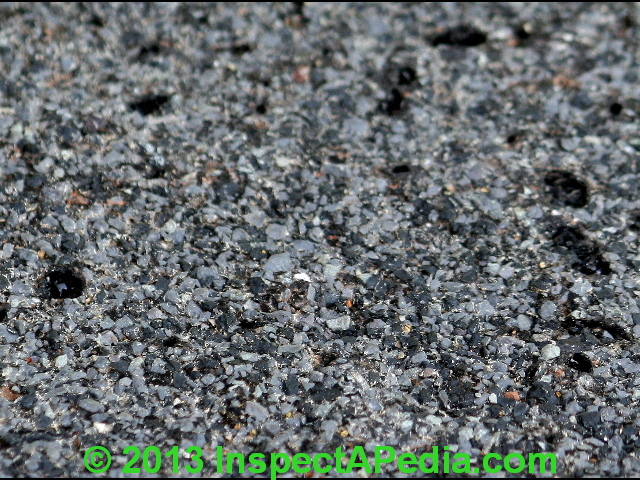Why Do Shingles Blister?

Blistering shingles are a common problem with asphalt shingles. There are two main reasons that asphalt shingles blister.
- Trapped Moisture in the Shingles
- Poorly Ventilated Roofs
Sometimes during the manufacturing process moisture can get trapped within the shingle itself. If the shingles on a roof have trapped moisture, they are highly likely to start blistering. Why? Because as the sun heats up the shingles the trapped moisture heats up as well and can cause blisters to rise up on the shingle.
Roofs that do not have an adequate ventilation system in place can get too hot for shingles. If a roof that is poorly ventilated gets too hot, the shingles can blister because of the intense heat.
Popped shingle blisters photo courtesy of InspectAPedia.com - used with permission
Are Blistering Shingles Bad?
This question could be answered with both a yes and a no answer. Let us explain.
No. As long as the blisters on the shingles keep their granules they will not cause a problem for the roof or longevity of the roof.
Yes. Like all blisters there comes a time that they will surely pop. When blisters pop on shingle roofs the granules become dislodged leaving the asphalt unprotected from the UV rays of the sun. When this happens that area of the roof is prone to continue to lose more and more granules. With time and natural weathering these popped blister areas can in fact lead to leaks and roof damage.
Prevent Blisters From Popping
If you already know that some of the shingles on your roof are blistering, here are some tips to help prevent them from popping.
- Be careful not to walk on the blistered shingles. Blistered shingles can pop when they are disturbed by foot traffic.
- Falling debris. Some homes are surrounded by trees. If you have trees that continue to drop pine cones, acorns, limbs, or other types of debris onto your roof, they could cause blisters to pop. removing these trees could be very beneficial to the life of your roof.
- Blisters can also pop because of hail storms. However, there is not much you can do about preventing hail from hitting your roof and ruining your asphalt shingles.
- Another method of prevention is to replace the asphalt shingles before they pop. This could be a costly repair based on how many shingles are blistered.
Distinguishing Blisters from Hail Damage
Distinguishing blister damage from hail damage can be confusing to some. We hope to lightly touch on some of the differences between the two in this section of the article.
One of the ways to distinguish the differences is by paying close attention to the damage pattern on the roof. Is the damage scattered? Is the damage only on one slope? Take close observation to the area, the slope, and overall direction of the damaged shingles.
For example, a shingle roof that has been damaged due to blisters being popped by foot traffic will also have parts of the rooftop that have un-popped blisters. In comparison, a roof that is damaged by hail will have much more uniform damage and on a particular slope because of the wind direction during the hail storm.
* For more information or photos of damaged shingles and the various causes State Farm has created a great pdf file to learn from.
Join Our Facebook Roofing Group
Hey everybody,
We are going social and have created a new Facebook group for people who want to know more about roofs, roofing problems, fixes, ask pros, etc. Feel free to join. It is a private group so once we get your request to join we will approve it as quickly as possible.
→ Join Here: Roofpedia Facebook Group!
Resources
Professionals Interviewed:
We would like to thank Daniel Friedman from Inspectapedia.com for contributing his knowledge to help us write this article.
Other Resources Used:
Shingle Blistering Article: A North Carolina General Contracting Company - pattoncontracting.com
PDF File about inspecting asphalt shingles by State Farm - statefarm.com





